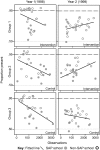Re-analysis of health and educational impacts of a school-based deworming programme in western Kenya: a statistical replication of a cluster quasi-randomized stepped-wedge trial
- PMID: 26203171
- PMCID: PMC4681108
- DOI: 10.1093/ije/dyv128
Re-analysis of health and educational impacts of a school-based deworming programme in western Kenya: a statistical replication of a cluster quasi-randomized stepped-wedge trial
Abstract
Introduction: Helminth (worm) infections cause morbidity among poor communities worldwide. An influential study conducted in Kenya in 1998-99 reported that a school-based drug-and-educational intervention had benefits for worm infections and school attendance.
Methods: In this statistical replication, we re-analysed data from this cluster quasi-randomized stepped-wedge trial, specifying two co-primary outcomes: school attendance and examination performance. We estimated intention-to-treat effects using year-stratified cluster-summary analysis and observation-level random-effects regression, and combined both years with a random-effects model accounting for year. The participants were not blinded to allocation status, and other interventions were concurrently conducted in a sub-set of schools. A protocol guiding outcome data collection was not available.
Results: Quasi-randomization resulted in three similar groups of 25 schools. There was a substantial amount of missing data. In year-stratified cluster-summary analysis, there was no clear evidence for improvement in either school attendance or examination performance. In year-stratified regression models, there was some evidence of improvement in school attendance [adjusted odds ratios (aOR): year 1: 1.48, 95% confidence interval (CI) 0.88-2.52, P = 0.147; year 2: 1.23, 95% CI 1.01-1.51, P = 0.044], but not examination performance (adjusted differences: year 1: -0.135, 95% CI -0.323-0.054, P = 0.161; year 2: -0.017, 95% CI -0.201-0.166, P = 0.854). When both years were combined, there was strong evidence of an effect on attendance (aOR 1.82, 95% CI 1.74-1.91, P < 0.001), but not examination performance (adjusted difference -0.121, 95% CI -0.293-0.052, P = 0.169).
Conclusions: The evidence supporting an improvement in school attendance differed by analysis method. This, and various other important limitations of the data, caution against over-interpretation of the results. We find that the study provides some evidence, but with high risk of bias, that a school-based drug-treatment and health-education intervention improved school attendance and no evidence of effect on examination performance.
Keywords: Helminth; Kenya; primary schools; randomized control trial; worms parasitic.
© The Author 2015. Published by Oxford University Press on behalf of the International Epidemiological Association.
Figures



Comment in
-
Commentary: Deworming externalities and schooling impacts in Kenya: a comment on Aiken et al. (2015) and Davey et al. (2015).Int J Epidemiol. 2015 Oct;44(5):1593-6. doi: 10.1093/ije/dyv129. Epub 2015 Jul 22. Int J Epidemiol. 2015. PMID: 26203170 No abstract available.
-
Authors' Response to: Deworming externalities and school impacts in Kenya.Int J Epidemiol. 2015 Oct;44(5):1596-9. doi: 10.1093/ije/dyv130. Epub 2015 Jul 22. Int J Epidemiol. 2015. PMID: 26203173 No abstract available.
-
How to make replication the norm.Nature. 2018 Feb 22;554(7693):417-419. doi: 10.1038/d41586-018-02108-9. Nature. 2018. PMID: 29469135 No abstract available.
References
-
- Bethony J, Brooker S, Albonico M, et al. Soil-transmitted helminth infections: ascariasis, trichuriasis, and hookworm. Lancet 2006;367:1521–32. - PubMed
-
- Steinmann P, Keiser J, Bos R, Tanner M, Utzinger J. Schistosomiasis and water resources development: systematic review, meta-analysis, and estimates of people at risk. Lancet Infect Dis 2006;6:411–25. - PubMed
-
- Partnership for Child Development T. The cost of large-scale school health programmes which deliver anthelmintics to children in Ghana and Tanzania. Acta Trop 1999;73:183–204. - PubMed
-
- Miguel E, Kremer M. Worms: Identifying impacts on education and health in the presence of treatment externalities. Econometrica 2004;72:159–217.
Publication types
MeSH terms
Substances
Grants and funding
LinkOut - more resources
Full Text Sources
Other Literature Sources
Medical

